Some sceptics believe Peak Oil is little more than a theory. However, last month, Fatih Birol, the chief economist of the International Energy Agency, told the Australian Broadcasting Corporation: "We think that crude oil production has already peaked, in 2006."
Birol’s comment is significant. In 2005, the executive director of the IEA said those who predicted Peak Oil were "doomsayers". Peak Oil is becoming an accepted fact of life. Oil will never get cheaper; driving will always go on becoming more and more expensive.
The expense of driving, and the fact being stuck in congestion is so depressing, is leading to something interesting. Something that should be financially fascinating to those in the bike trade, even those wedded to their swish cars and their fancy vans.
People are driving less and it’s not just a blip thing, not just because of the recession. People are driving less because driving has become less attractive.
You’ve heard of Peak Oil. Get ready for Peak Cars. This is the idea that mass motoring has reached its peak and is now in decline. For the bike trade this is potentially transforming. While car dealers think they’re on to a good thing, in fact, they’re not. Over the next few years they’re going to be fighting over a decreasing number of customers. Bike shops, on the other hand, if the theory of Peak Cars is right, can look forward to an expanding market, as more and more people discover bicycles.
The theory of Peak Cars is from the fertile mind of Phil Goodwin, professor of transport policy at the University of the West of England in Bristol. But it’s not his theory alone. Many academics now support Professor Goodwin’s position. He will expand more on the idea in a forthcoming book, ‘Automobility in Transition’ (Routledge), in which he’s just one of the authors, all of whom are roughly saying the days of mass motoring have peaked.
Transport mode-flips are normal. Consider railways. At the beginning of the 20th Century this once dominant form of transport looked like it would expand for ever, with motorcars a luxury for the landed gentry, never for oiks. But Peak Trains took place in the 1920s, cars soon took over, and cities once shaped for railways were, instead, shaped around unfettered use of cars.
In the near future cars won’t disappear (trains haven’t) but if a transport mode is in decline, even a very small decline, there’s less need to create infrastructure for that mode. Why build more motorways when use of such infrastructure is likely to decrease? Transport modes in the ascendency need the infrastructure spend. Yep, that’s right: bicycles. (And light rail, but that’s for another trade mag to champion).
The statistics show that car use – so bone-crushingly dominant right now – is falling and is falling at a steady, predictable rate. This runs contrary to Department for Transport predictions that congestion will keep on increasing for the next 30 years but Professor Goodwin shows that officials also failed to predict Peak Trains and Peak Buses, assuming instead that these then dominant forms of transport would never reach ‘saturation point’.
Officials today assume car driving will rise and rise. Many academics are not so sure. Between 1992 and 2007, the proportion of 17-to-20-year-olds holding a driving licence fell from 48 per cent to 38 per cent and that of 21-to-29-year-olds from 75 per cent to 66 per cent.
In London, ‘Peak Car’ happened in the 1980s. Car-use has been in steady decline ever since, with more use being made of buses, the underground and, of course, bicycles.
In Edinburgh, campaign group Spokes has conducted city centre peak-period traffic counts over a number of years and each successive year has shown a decline in private motor traffic and each year an increase in cycle use.
While many young people are turning their backs on cars, preferring a train or bus commute with Angry Birds on an iPad, others are waking up to the real freedom offered by bicycles.
It could take another 50 years to confirm whether cars went the same way as trains, buses and trams, but the decline is measurable and, to academics at least, plain to see. Policy makers will have to to wise up and plan for a future with fewer cars, and a lot more bicycles.
 BikeBiz Bicycle and cycling retail news
BikeBiz Bicycle and cycling retail news



